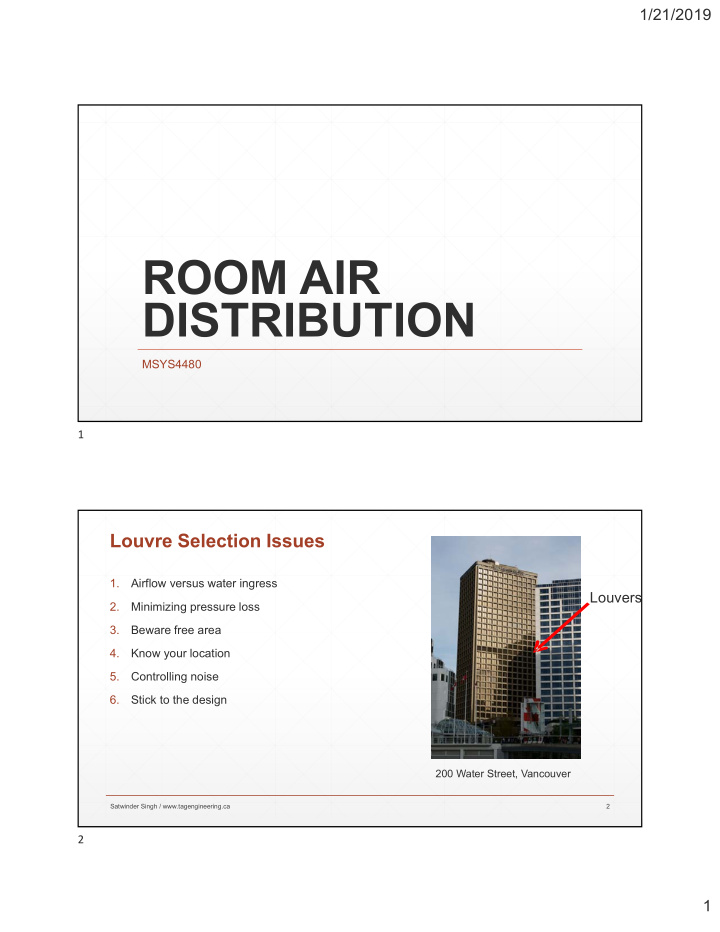



1/21/2019 ROOM AIR DISTRIBUTION MSYS4480 1 Louvre Selection Issues 1. Airflow versus water ingress Louvers 2. Minimizing pressure loss 3. Beware free area 4. Know your location 5. Controlling noise 6. Stick to the design 200 Water Street, Vancouver Satwinder Singh / www.tagengineering.ca 2 2 1
1/21/2019 Louvres 39 38 Satwinder Singh / www.tagengineering.ca 3 3 Sloped Plenum Detail Satwinder Singh / www.tagengineering.ca 4 4 2
1/21/2019 Louvre Types • Traditional louvres provide protection from non-storm rain • Wind Driven Rain Resistant louver provide storm condition protection • Let’s look at the differences… Satwinder Singh / www.tagengineering.ca 5 5 Louvres Traditional Louvres: • Horizontal blades • Drain Gutters • Wide Spacing • High free area • Low cost • Stops some rain • Not effective in storms Satwinder Singh / www.tagengineering.ca 6 6 3
1/21/2019 Louvres Traditional Louvre Sizing: • AMCA water penetration test – Beginning point of water penetration free area velocity (FAV) • Determine design FAV considering AMCA test data • CFM/FAV = Total free area required • Reference louvre free area guide to determine appropriate louvre size Satwinder Singh / www.tagengineering.ca 7 7 Water Penetration Graph .01 oz./ft, of free area Satwinder Singh / www.tagengineering.ca 8 8 4
1/21/2019 Air Performance Rating Satwinder Singh / www.tagengineering.ca 9 9 Traditional Louvres Where to use: • Properly drained applications • Sloped plenums & ductwork • Floor drains • Protected areas (overhangs, barriers, interiors, non-prevailing wind elevations) • “Screen” applications (vision barriers) Sizing • Use safety factor of 15 to 20% Note • Does not stop storm rain Satwinder Singh / www.tagengineering.ca 10 10 5
1/21/2019 New Louvres Wind Driven Rain Louvres • Horizontal or Vertical blades • Drain Gutters on horizontal • Hooks on vertical • Close spacing • Lower free area • Higher velocity • Effective in storms Satwinder Singh / www.tagengineering.ca 11 11 Wind Driven Rain Louvres Vertical Blade Models Horizontal blade models 40% - 45% 40% - 50% free area free area 3” to 7” deep 2” to 8” deep Class A @ Class A @ 1500 to 2100 800 to 1200 fpm fpm Low ∆ p Moderate ∆ p Best Traditional performance appearance Satwinder Singh / www.tagengineering.ca 12 12 6
1/21/2019 Wind Driven Louvre Benefits Prevent rain infiltration • Lessens interior water damage & mold growth • Helps keep walls & floors dry • Helps keep filters dry • Excellent for penthouses Allow higher intake velocities • Use smaller louvres Reduce future problems & liability Satwinder Singh / www.tagengineering.ca 13 13 Sizing Example 48” x 48” & 7,000 cfm 6” Traditional 5” Horizontal WDR 6” Vertical WDR • • • 710 fpm 1,002 fpm 1,030 fpm • • • .07” ∆p .16” ∆p .09” ∆p • • • 60% Wind Driven 99.8% Wind Driven 99.8% Wind Driven • • • Rain Effectiveness Rain Effectiveness Rain Effectiveness (50 (29 mph) (29 mph) mph) Cost 1.0 Cost 1.7 Cost 2.7 • • • 48” x 36” (25% smaller) • 1,488 fpm • .18” ∆p • 99.8% Wind Driven Rain • Effectiveness (50 mph) Cost 2.3 • Satwinder Singh / www.tagengineering.ca 14 14 7
1/21/2019 Rooftop Intakes Traditional style, allows Wind Driven Rain Design, prevents rain penetration rain penetration Satwinder Singh / www.tagengineering.ca 15 15 What About Snow? Prevent snow infiltration • Heated screens behind louvres • Reasonable pressure drop • Relatively slow airflow – 350 FPM face velocity Satwinder Singh / www.tagengineering.ca 16 16 8
1/21/2019 Common Accessories Bird and insect screens Insulated blank off Acoustic Screens prevent louvres from plates are used when becoming nests future capacity is planned but yet needed Satwinder Singh / www.tagengineering.ca 17 17 Standard 500-L Louvres Waterdrop Manifold Wetted Wall Manifold Air Exhaust Water Test Unit Droplets Air Entrained “Still Air” into chamber Condition! through louver Exhaust Air Flow Collection Fan Measurement Zone Satwinder Singh / www.tagengineering.ca 18 18 9
1/21/2019 Std 500-L Wind Driven Rain Test 5.11 Water Rejection Wind Driven Rain Air Exhaust Test Louver Rain Water Wind/Rain Discharge Machine Nozzles Wind Driven Rain plus Air Entrained Into Chamber Through Louver Exhaust Fan Collection Zone 52 Satwinder Singh / www.tagengineering.ca 19 19 Std 500-L Wind Driven Rain Test • Rejection Effectiveness Classes A 99% to 100% B 95% to 98.9% C 94.9% to 80% D below 80% (std. louvers) • 3” rain/29 mph wind • 8” rain/50 mph wind 53 Satwinder Singh / www.tagengineering.ca 20 20 10
1/21/2019 Rear view, 29 mph wind, 3”/hr rain, 2,000 fpm intake velocity Satwinder Singh / www.tagengineering.ca 21 21 How Much Water Is Applied? • 3” Per Hour Rain On 1m X 1m • 21 Gallons Applied Over 1 Hr. – Class A (99% or better) allows 27 fl. oz penetration – Class D (80% or worse) allows over 4 gallons – Std Louvers (60% or lower) - over 7 gallons Satwinder Singh / www.tagengineering.ca 22 22 11
1/21/2019 Standard 500-L Louvres Test Conditions • 48” x 48” size • 15 minute intervals • Manifold (raindrops) - 4” per hour (3.15 gal/15 min) • Wetted wall - .25 gpm (3.75 gallons/15 min) • Ventilation airflow only – no wind • 1250 fpm max free area velocity Satwinder Singh / www.tagengineering.ca 23 23 AMCA “Still Air” Water Test Satwinder Singh / www.tagengineering.ca 24 24 12
1/21/2019 “Still Air” Test with Non-drainable Louvre Satwinder Singh / www.tagengineering.ca 25 25 Traditional Drainable Louvre 29 mph wind, 3”/hr rain, 1,000 fpm intake velocity Satwinder Singh / www.tagengineering.ca 26 26 13
Recommend
More recommend